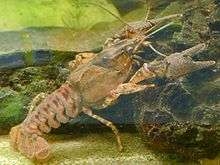Orconectes limosus
| Orconectes limosus | |
|---|---|
 | |
| Scientific classification | |
| Kingdom: | Animalia |
| Phylum: | Arthropoda |
| Subphylum: | Crustacea |
| Class: | Malacostraca |
| Order: | Decapoda |
| Family: | Cambaridae |
| Genus: | Orconectes |
| Species: | O. limosus |
| Binomial name | |
| Orconectes limosus (Rafinesque, 1817) | |
Orconectes limosus is a species of crayfish in the family Cambaridae. It is native to the east coast of North America, from Maine to the lower James River, Virginia, but has also been introduced to Europe.[2] It is known commonly as the spinycheek crayfish.[1]
It is unusual in that it lives in silty streams, rather than the clear water usually preferred by crayfish.[3] Like Pacifastacus leniusculus, another invasive North American crayfish, O. limosus carries crayfish plague and is a threat to native European crayfish.[4]
O. limosus was introduced to Germany in 1890, and has since spread across much of Northern Europe, recently reaching the United Kingdom.[4] It has also spread southwards as far as the Danube in Serbia.[5]
Orconectes limosus can reproduce sexually or by parthenogenesis.[6] Lobsters and Crayfish are decapods meaning that they have 10 legs. 2 of them are claws. These Crayfish live on the bottom of the freshwater pools, such as lakes, ponds and swamps. They prefer flat, sandy, and rocky floors. They are also found outside the water on beaches or lawns near the pool of water. They use rocks to make burrows while in the water. This is a very common species of cray, especially on Northeast United States, and Southeast Canada.
References
- 1 2 Adams, S., Schuster, G.A. & Taylor, C.A. 2010. Orconectes limosus. The IUCN Red List of Threatened Species 2010. Downloaded on 16 June 2016.
- ↑ James W. Fetzner, Jr. (December 6, 2006). "Orconectes (Faxonius) limosus (Rafinesque, 1817)". Crayfish Taxon Browser. Carnegie Museum of Natural History.
- ↑ Whitney Stocker. "Orconectes (Faxonus) limosus (Rafinesque, 1817)". Retrieved August 29, 2007.
- 1 2 David Holdich & John Black (2007). "The spiny-cheek crayfish, Orconectes limosus (Rafinesque, 1817) (Crustacea: Decapoda: Cambaridae), digs into the UK" (PDF). Aquatic Invasions. 2 (1): 1–16. doi:10.3391/ai.2007.2.1.1.
- ↑ S. Pavlović, S. Milošević, S. Borković, V. Simić, M. Paunović, R. Žikić & Z. Saičić (2006). "A report of Orconectes (Faxonius) limosus (Rafinesque, 1817) (Crustacea: Deacpoda: Astacidea: Cambaridae: Orconectes: subgenus Faxonius) in the Serbian part of the River Danube". Biotechnology & Biotechnological Equipment. 20 (1): 53–56.
- ↑ M Buřič; M Hulák; A Kouba; A Petrusek; P Kozák (2011). "successful crayfish invader is capable of facultative parthenogenesis: a novel reproductive mode in decapod crustaceans". PLoS ONE. 6 (5): e20281. doi:10.1371/journal.pone.0020281. PMC 3105005
 . PMID 21655282.
. PMID 21655282.
External links
 Media related to Orconectes limosus at Wikimedia Commons
Media related to Orconectes limosus at Wikimedia Commons
